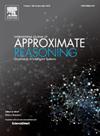Information fusion based conflict analysis model for multi-source fuzzy data
IF 3
3区 计算机科学
Q2 COMPUTER SCIENCE, ARTIFICIAL INTELLIGENCE
引用次数: 0
Abstract
Conflict is ubiquitous in life. Conflict analysis is a tool for understanding conflicts, whose aim is to analyze the conflict situations in data to help decision makers avoid risks. Existing conflict analysis methods mainly focus on single-source data. However, the emergence of big data era has generated more complex data, such as multi-source data obtained from different perspectives, which can capture details that single-source data is missing. Not only that, most data also exhibit characteristics of fuzziness. The above situations make it more challenging to construct a conflict analysis model in the environment of multi-source fuzzy data to acquire a compliant decision. Therefore, conflict analysis for multi-source fuzzy data is a worthy research topic. However, the existing few studies on multi-source fuzzy data either favor attribute values or ignore conflict resolution, which reduces the conflict resolution performance due to underutilizing attribute information. To solve the above problem, we divide the attribute values of multi-source fuzzy data into three attitude intervals to distinguish different attitudes of agents. Then, we propose a function to measure conflict and construct a conflict analysis model for a multi-source fuzzy formal context. Additionally, we put forward an information fusion method based on the minimum of fuzzy entropy, whose purpose is to achieve conflict resolution quickly. Finally, experiments conducted on 18 datasets demonstrate that our information fusion method can achieve conflict resolution effectively, and provide a useful reference for decision-makers.
基于信息融合的多源模糊数据冲突分析模型
冲突在生活中无处不在。冲突分析是一种理解冲突的工具,其目的是分析数据中的冲突情况,帮助决策者规避风险。现有的冲突分析方法主要集中在单源数据上。然而,大数据时代的出现产生了更复杂的数据,比如从不同角度获得的多源数据,可以捕捉到单源数据所缺失的细节。不仅如此,大多数数据还具有模糊性。上述情况使得构建多源模糊数据环境下的冲突分析模型以获得符合的决策变得更加困难。因此,多源模糊数据的冲突分析是一个值得研究的课题。然而,现有的多源模糊数据的研究要么偏重于属性值,要么忽略了冲突的解决,导致属性信息利用不足,影响了冲突的解决效果。为了解决上述问题,我们将多源模糊数据的属性值划分为三个态度区间,以区分agent的不同态度。然后,我们提出了一个度量冲突的函数,并构建了多源模糊形式上下文的冲突分析模型。在此基础上,提出了一种基于模糊熵最小的信息融合方法,以快速解决冲突。最后,在18个数据集上进行的实验表明,我们的信息融合方法可以有效地解决冲突,为决策者提供有用的参考。
本文章由计算机程序翻译,如有差异,请以英文原文为准。
求助全文
约1分钟内获得全文
求助全文
来源期刊

International Journal of Approximate Reasoning
工程技术-计算机:人工智能
CiteScore
6.90
自引率
12.80%
发文量
170
审稿时长
67 days
期刊介绍:
The International Journal of Approximate Reasoning is intended to serve as a forum for the treatment of imprecision and uncertainty in Artificial and Computational Intelligence, covering both the foundations of uncertainty theories, and the design of intelligent systems for scientific and engineering applications. It publishes high-quality research papers describing theoretical developments or innovative applications, as well as review articles on topics of general interest.
Relevant topics include, but are not limited to, probabilistic reasoning and Bayesian networks, imprecise probabilities, random sets, belief functions (Dempster-Shafer theory), possibility theory, fuzzy sets, rough sets, decision theory, non-additive measures and integrals, qualitative reasoning about uncertainty, comparative probability orderings, game-theoretic probability, default reasoning, nonstandard logics, argumentation systems, inconsistency tolerant reasoning, elicitation techniques, philosophical foundations and psychological models of uncertain reasoning.
Domains of application for uncertain reasoning systems include risk analysis and assessment, information retrieval and database design, information fusion, machine learning, data and web mining, computer vision, image and signal processing, intelligent data analysis, statistics, multi-agent systems, etc.
 求助内容:
求助内容: 应助结果提醒方式:
应助结果提醒方式:


